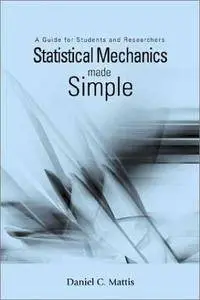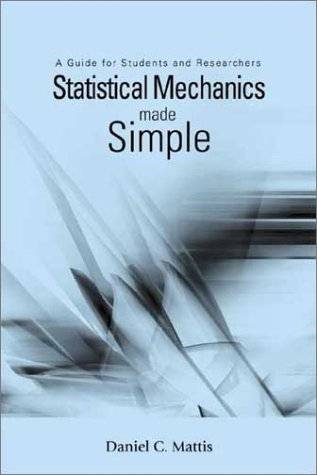Daniel Charles Mattis, "Statistical Mechanics Made Simple: A Guide for Students and Researchers"
2003 | ISBN: 981238166X | 268 pages | PDF | 2 MB
2003 | ISBN: 981238166X | 268 pages | PDF | 2 MB
This text is an elaboration of the author's lecture notes on a graduate course in thermodynamics and statistical mechanics. The original notes supplemented topics lacking in traditional texts. In its present augmented version the text may be used as the sole or primary text in a one-semester course in thermodynamics/statistical mechanics or as an adjunct text in a two-semester course. Statistical mechanics is the application of physics or chemistry at finite temperature T and can encompass as many topics involving these disciplines as one wishes. This work is intended to respond to the curiosity of the reader about fundamental principles. It shows in detail how one solves the problems that arise in connection with these principles. There are some 50 problems scattered throughout the text and a similar number of illustrations. All the mathematics is self-contained, including the development of field-theoretic methods in the later, more difficult, chapters. The emphasis is not just on the topics, but on the mathematics used to understand them and on the methods of solution. The volume starts by answering the following questions: Where does thermodynamics "come from"? What is temperature and how might one achieve negative temperatures (metastable states) for interacting spins? What are the various free energies and how do they differ? What is an equation of state and what is the nature of thermodynamic phase transitions? Why does the modern theory of critical-point phenomena disagree with van der Waals' original Law of Corresponding States? The text also includes a number of nonstandard topics, such as the exact construction of the thermodynamic properties in one-dimensional systems and the generalization to "transfermatrices" with which to solve for the free energy and correlations in translationally invariant systems of all sorts. It provides the exact solution to a model Boltzmann equation for the electrical conductivity of a metal or semiconductor -thereby pinpointing the sources of Joule heating. There are sections on the propagation and dissipation of sound waves in a fluid, obtained by finding the solutions to the same linearized Boltzmann equation in the representation of eigenstates of the two-body collision operator. In fact, the use of operators and operator algebra to solve coupled linear equations is a main characteristic of this book. One obvious application is to superfluidity and superconductivity. In addition to the Bogoliubov treatment of the weakly interacting Bose gas, the author also demonstrates the Feynman-Cohen semiphenomenological theory. He considers superconductivity both thermodynamically and from the microscopic point of view of BCS theory. He uses the quantum field theory of Doi to model the "master equation" for diffusion-limited chemical reactions and uses the solutions to calculate the various rates and other properties. He discusses the Mermin-Wagner-Hohenberg theorem, which precludes long-range order in low-dimensional systems. Finally, he derives the thermodynamic Green functions and their equations of motion and apply them to glassy and amorphous materials. This allows a fairly detailed resolution of the well-known conundrum: Why does the T3 heat capacity of crystalline materials suddenly become linear in T when applied to glass, and what happens to the propagation of long-wavelength sound in the glassy material?



